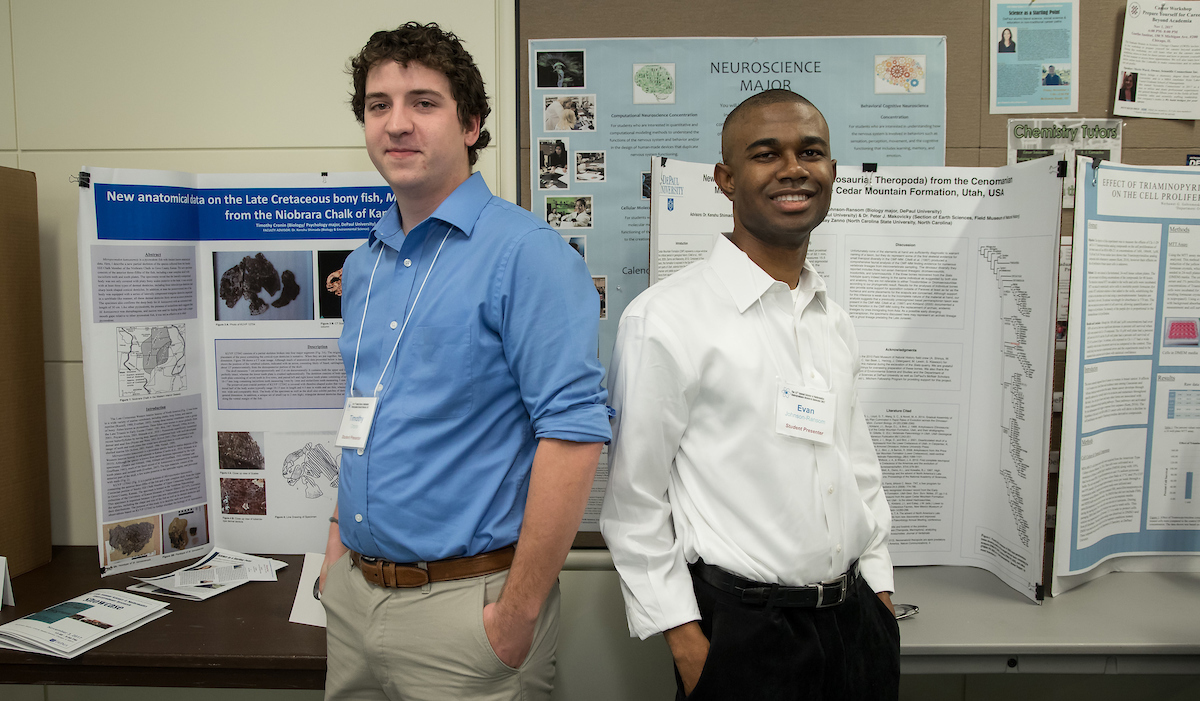 Timothy Cronin (left) and Evan Johnson-Ransom were two of the more than 80 DePaul students who shared their research at the College of Science and Health's 15th Annual Science and Mathematics Undergraduate Research Showcase in fall 2017. (DePaul University/Jeff Carrion)
Timothy Cronin (left) and Evan Johnson-Ransom were two of the more than 80 DePaul students who shared their research at the College of Science and Health's 15th Annual Science and Mathematics Undergraduate Research Showcase in fall 2017. (DePaul University/Jeff Carrion)
What do charcoal and gardening have in common? Want to know more about T-Rex's cousin, the coelurosaurian? Ask one of the 80 DePaul students who participated in the 15th annual Science and Mathematics Undergraduate Research Showcase last fall.
Each year, the symposium gives students in the College of Science and Health, College of Liberal Arts and Social Sciences, and College of Computing and Digital Media an opportunity to present their research projects to the university community. From chemistry and nutrition to paleontology and physics, students in the showcase demonstrate their academic excellence and passion for the sciences.
"This showcase helps students determine if they want to pursue a research-based career and, if so, what path they actually want to take," says Victoria Simek, the associate director of STEM Studies at DePaul University. "Beyond that, students are able to work closely with faculty members and science-related organizations across Chicago, such as Lincoln Park Zoo, The Field Museum and others. This gives them a taste of how professional collaborations work outside of a classroom setting."
Here Newsline breaks down a few of this year's research projects:
Nurturing nutrition at the Shedd Aquarium
For many, charcoal and gardening may not seem to go hand-in-hand. But for Madelyn Draftz, a DePaul senior studying biology, the pair makes perfect sense. As part of the College of Science and Health's Dean's Undergraduate Fellowship, Draftz spent 11 weeks at the Shedd Aquarium assessing the effects of integrating biochar into garden soil.
Biochar is a type of charcoal that is rich in carbon, used in soil amendment and thought to increase the nutrition, health and production of crops. Rather than importing food products for some of its animals, the aquarium grows its own, ultimately saving money and providing animals with more nutritious meals.
In addition to working to determine if biochar could increase the nutrition rate and production of food, Draftz also examined if biochar could reduce algae growth in the aquarium's wetland waters, such as the ponds near the Shedd.
"The results were inconclusive for the wetlands," Draftz says, "However, I did discover biochar can increase the amount of crops produced and help the gardens to provide healthier food for the animals. Based on this research, the aquarium is looking into ways to integrate biochar into its soils."
Digging up dinosaurs
Evan Johnson-Ransom, a senior studying biology, teamed with DePaul's department of biology and The Field Museum to develop his research project. An Arnold Mitchem Fellow and member of DePaul's McNair Scholars program, Johnson-Ransom worked to identify dinosaur remains found in the Cedar Mountain Formation, a specific sedimentary formation in Utah known as a site for numerous fossil discoveries.
In 2010, The Field Museum excavated several bones, specifically a humerus, a scapula and a broken radius, from multiple dinosaurs. After looking at size, length and circumference of these bones, Johnson-Ransom and his team determined they belonged to a coelurosaurian dinosaur, a subgroup of theropod dinosaurs, the same group as the more commonly known tyrannosaurus rex.
"These fossils are the first of its kind for small theropod dinosaurs," Johnson-Ransom says. "Working on this project during these discoveries has been thrilling and has helped me solidify my decision to pursue a career in paleontology."
Making technology accessible
Back in the classroom, Ellie Martin-Eberhardt used her time and physics expertise to develop an inexpensive frequency counter. Most often used to measure and count electrical signals in various physics experiments, accurate frequency counters that can measure large ranges are expensive and not accessible to everyone. After developing three prototypes, Martin-Eberhardt was able to create an accurate frequency counter for around $10.
"The instruments I developed this year are ideal for classrooms and schools because the device is inexpensive and easy to make," Martin-Eberhardt explains. "It's wonderful to think more people could have access to physics-based experiments and learning because of this simple tool. I'm thankful to have been part of this showcase and to share my work with the DePaul community."